
by: Rev. Cheryl L. Hauer, International Development Director
From the highest heavens to the deepest ocean, from the smallest insect to the leviathan, our Heavenly Father has often used the world around us to help us know Him better. He is a God whose eyes are continually on His creation, who sees into our hearts, who looks to and fro across the earth…a God to whom vision is important. Since we are created in His image, we are beings who not only rely on our sense of sight, but learn best by seeing. You might say we serve the God of visual aids. His Word is filled with tangible examples of spiritual concepts designed to help us better understand how we should behave or to bring clarity to complicated spiritual concepts. We are told of the advantages of being like a green olive tree in the house of the Lord (Ps. 52:8) or receiving blessing like a tree planted by streams of water (Ps. 1:3). As His covenant relationship with His people grew and strengthened, He often instructed them by creating other kinds of visual aids that would become a part of daily life and serve as constant reminders of His presence, His love, and His instructions for living.
Deuteronomy 6:8–9 became the foundation for the creation of some of the most important of such visual aids in the life of the nation of Israel. God’s instruction to bind His words as a sign on the hand and on the forehead gave birth to the tefillin, small leather boxes containing Scripture that are worn by religious Jewish men during times of prayer.
The injunction to write His Word on the doorposts of the house prompted the creation of the mezuzah, a small box containing the same verses of Scripture and placed on the doorposts of the homes of Jewish people the world over. The prayer shawl, or tallit,one of the most well-known of all Jewish ritual objects, became the vehicle for carrying the tzitziyot. These tassels, which are twisted and knotted in a specific manner to represent the 613 commandments found in the Torah (Gen.–Deut.), were created in obedience to God’s instructions in Numbers 15 and Deuteronomy 23.
These amazing visual aids and the words of God they represent are foundational to Judaism, and throughout the ages, countless lessons for life have been drawn from them. The rabbis have taught that the Lord took these seven precepts (the four tzitziyot,one tefillin for the forehead and one for the hand, and one mezuzah) and built Israel a house in which she could live in covenant relationship with her God. In other words, these items are constant visual reminders of principles that would provide the protection, instruction, and awareness of God’s presence that would keep Israel safely hidden under the shadow of the Almighty.
In the New Testament, God continues to reveal Himself with that same clarity through the word picture or visual aid, and none of the New Testament writers was more adept at its use than the Apostle Paul. Sitting at the feet of the famous Rabbi Gamaliel, Paul was immersed in Old Testament study and readily brought the teaching techniques he encountered there to his first-century students. Many of them were Gentiles who had no background in the Scriptures, but he encouraged them to serve the Lord with the same commitment and purity of heart as Moses, David, and other examples from Israel’s history. He took every opportunity to admonish them that the enemies of the Lord were as determined to destroy them as they had been to annihilate God’s children in past generations. Paul repeatedly told his followers that the fledgling Church was at war with spiritual enemies who would use every means of deceit and discouragement to have victory over the people of God.
Surely, Paul felt the effects of that spiritual battle as he found himself in official Roman custody from around 60 to 64 AD. Certainly, he would have labored in prayer for the dozens of new congregations he had started on his journeys as he heard of their treatment under Roman oppression. Through his letters to those congregations, Paul encouraged them to remain strong in the faith, displaying the love of Yeshua (Jesus), working together to make the unity of the body of Christ a reality. He admonished them to be aware of the spiritual conflict that was a constant reality for them and to stand against the attacks of the evil one, remaining strong in the power of the Lord.
In light of Paul’s circumstances, it is not surprising that the Roman military uniform figured heavily in his teaching as a vivid and effective visual aid. He certainly had every opportunity to observe that armor and contemplate its application to the warfare the young churches faced. Further, all of those churches were keenly aware of the Roman military machine itself and the danger it presented to all who would opposed it. It was the mightiest army in the known world; it was an occupier, setting up Roman government, religious, and social institutions everywhere it went; it would take every inch of ground that a weaker, less prepared, or less alert opponent would allow.
As he wrote to his congregation in Ephesus, the city that was to become his center for outreach to the rest of the province of Asia, his message was clear. Whether they recognized it or not, the Ephesians were engaged in a very real battle, not so much against the cultists, false religionists, and atheists that they encountered on a daily basis, but with demonic forces who were their real enemies. Such enemies were the strongest opponents the churches would face. They were occupiers; they would take every inch of ground that they were allowed. It was critical that the churches understood the enemy and the battle they were facing. And through a look at their Roman oppressors, Paul would teach them how to fight that battle.
“Finally my brethren be strong in the Lord and in the power of His might. Put on the whole armor of God that you may be able to stand against the wiles of the devil. For we do not wrestle against flesh and blood, but against principalities, against powers, against the rulers of the darkness of this age, against spiritual hosts of wickedness in the heavenly places. Therefore be able to withstand in the evil day, and having done all to stand. Stand therefore having girded your waist with truth, having put on the breastplate of righteousness, and having shod your feet with the preparation of the gospel of peace; above all, taking the shield of faith with which you will be able to quench all the fiery darts of the wicked one. And take the helmet of salvation, and the sword of the Spirit which is the word of God, praying always with all prayer and supplication”(Eph. 6:10–18a).
These are Paul’s words to the Ephesians, some of the most famous in all of the New Testament. The message is powerful and practical, beginning with his choice of words. In verse 11, he tells the Ephesians to “stand” against the wiles of the enemy, using a Greek word that means “to vigorously, strongly and actively oppose.” In verse 12, the word used for “wrestle” is the same word used for that activity in the public games, indicating a very real battle. In verse 13, the word “withstand” has the connotation of being the last man standing. When the battle is over and the battlefield is littered with the dead and dying, the Ephesians were to be on their feet, victorious, and preparing for the next battle.
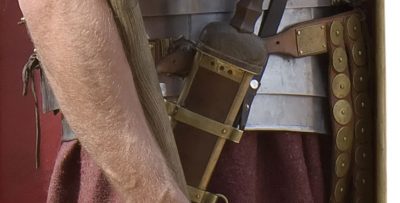
Belt (Photo: shutterstock)
It is interesting that Paul begins his discussion, not with the armor or the helmet, but with the belt. As a part of the uniform, the belt was important as a means to carry smaller weapons, or to “gird up the loins,” creating a sort of pantaloon that gave the soldier more mobility. It is significant ,however, that at this point in Roman history, an unbelted tunic was a symbol of shame, indicative even of weakness, effeminacy, or laziness. If a soldier needed to be disciplined by a superior officer, he would often be humiliated in front of his peers by being stripped of his belt. To the Ephesians, Paul says the truth of God is a symbol, not of weakness or laziness, but of power and is the foundation that supports all other weaponry. The enemy is the father of lies, and integrity, practical truthfulness,
and honesty is a necessity for victory.
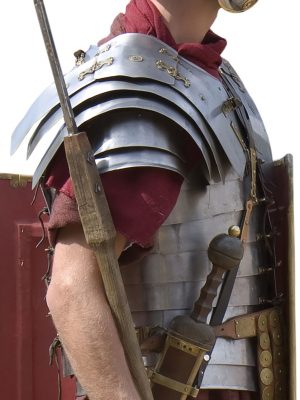
Breastplate (Photo: shutterstock)
The overlapping metal strips of the Roman breastplate made it virtually impenetrable. It covered both the front and back of the soldier and had additions for each arm. Though it provided incredible protection, it was heavy and awkward to wear and required a great deal of training to be worn effectively. It often chafed a soldier’s skin, creating sores that could be incapacitating. To keep this from happening, a tunic was worn under the armor, but a special piece was needed to protect the neck from chafing. This piece of bright red fabric was called the focale. Although it protected the skin from chafing, it created a vivid target for enemy archers who could kill the Roman soldier with one arrow strategically aimed where the focale protruded from the breastplate at the base of the throat. Some believe this is where the term “focal point” is derived from.
Paul says the breastplate that will protect the Ephesians is righteousness. Here, he is referring to practical righteousness, the right choices a believer must make every day to stand against temptation and live a life of godliness. That kind of righteousness, however, can be heavy and uncomfortable, sometimes even awkward. Each compromise made to eliminate the chafing could create a focale: the perfect target for the enemy.
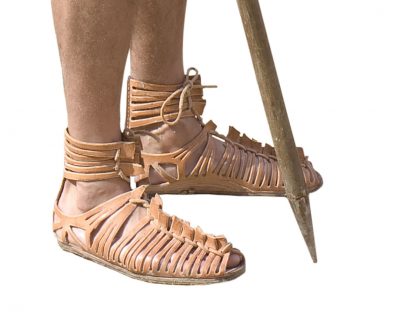
Photo: shutterstock
Roman shoes were called the caligulae and are the most common article found in archaeological digs of Roman sites. Made of leather, the shoe’s longevity comes from the many pieces of metal, or hob nails, imbedded in the bottom. These unique additions to each shoe gave them remarkable longevity, making them seemingly last forever. They also provided great traction for the soldier who had to climb slippery rocks or run through loose sand. And they turned each shoe into a weapon. If an enemy had been knocked down but not subdued during hand to hand combat, one stomp with the caligula could easily spell death. Here, Paul reminds the Ephesians that the gospel is the key to longevity: the believer will indeed last forever! Further, it will keep the believer from slipping and falling, regardless of the surface being walked on. And one stomp with the shoes of the gospel will stop the enemy in his tracks.
The Roman helmet worn during the first century was of unique construction. It was designed to give the illusion of height, making the soldier even more intimidating. It was outfitted with neck and ear guards. It was also reinforced inside with several metal rods to protect the soldier from a weapon called the falx. This three-foot, curved blade mounted on a three-foot wooden handle was a deadly “slash and sever” weapon. One swipe with the curved blade could sever a limb or instantly decapitate an enemy. Or a blow brought down upon the head could easily split it in half. The metal rods kept this from happening. Here, Paul warns his readers that the head will be a particular target. If the enemy could keep the Ephesians from being transformed through the renewing of their minds, if he could whisper lies in their ears, he could be victorious. Paul’s answer was to walk constantly and purposefully in the firm knowledge of their salvation.
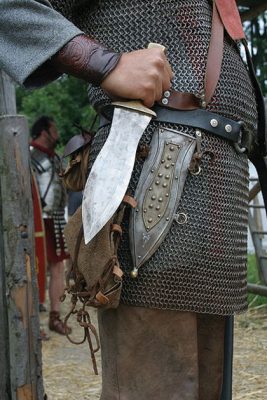
Photo: wikipedia
Each Roman soldier carried several weapons. The standard javelin was a long-distance weapon, although sometimes an additional short-distance javelin was also carried. Each soldier carried a spatha,or gladiator sword, as well as a smaller, lighter one. The belt held a side dagger, and inside the shield were five lead-weighted darts called plumbatae. These darts were barbed and could quickly kill a man or a horse. However, the barbs caused such excruciating pain that anyone hit by them was immediately incapacitated. For this reason, the plumbatae were often refered to as “fiery darts.” The Roman soldier, therefore, actually carried a private arsenal, not just a weapon. It was imperative that he knew his weapons well, was able to make split-second decisions as to which one to use, and had the coordination to switch from one to the other.
The sword of the Spirit is the only truly offensive weapon that Paul mentions, and the imagery is strong and clear. If the Ephesians were to effectively use their arsenal, they had to know it and know it well. They would have to discern what part of it to use when, as Yeshua did when Satan tempted Him in the wilderness. The enemy was defeated when very specific words were used to counter the enemy’s specific attacks.
The Roman shield was constructed so that its curved shape deflected blows, arrows, and darts. It was made of several layers of wood and covered with lacquered canvas and calf skin. It was a hand’s-width thick and reinforced with iron edging, and few weapons of that day could penetrate it. When Paul tells the Ephesians that their faith will be their shield, he is not talking about mental assent or belief. In typical Hebraic fashion, he is referring to faithfulness: a life marked by constant commitment to godly living, which would create strong, thick shields with solid edges, able to deflect all that the enemy would fire.
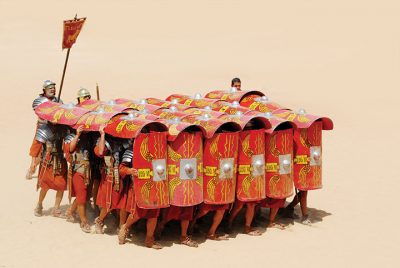
Testudo formation (Photo: shutterstock)
Just as Paul’s readers would have been familiar with the Roman military machine and the armor worn by the Roman soldier, they would have been familiar with Roman military formations. The imagery of the testudo, or tortoise formation held a strong message for the churches of Paul’s day and today as well. The tortoise was formed when a command was given on the battlefield and certain of the soldiers began to create the perimeter of a square. Immediately other soldiers filled the center, and the final perimeter was drawn, so that in seconds, a square mass of soldiers had been formed.
The soldiers of the perimeter quickly locked their shields together, creating an impenetrable wall around them all. The soldiers inside the perimeter raised their shields above their heads and locked them as well, effectively creating the semblance of a tortoise who had withdrawn its head into its shell. One soldier was commissioned to be the eyes of the testudo, shouting out orders so that each soldier, even the one in total darkness at the very center of the square, could hear that one voice and know where and how to step so that the entire mass could continue to move forward in an absolutely impenetrable formation.
What a tremendous picture Paul has painted for the Ephesian church! He has challenged each believer with their individual responsibility to understand the enemy, anticipate the battle, and know his own armor well. He has used powerful imagery to help each one understand how to use that armor, perhaps even to symbolically put it on every day, being reminded of the power God has given each believer to be victorious in every situation.
But a single soldier cannot hold out very long. Paul’s readers were well aware of the disciplined fighting force the Romans represented and his use of such imagery admonished them to take their positions as part of just such an army. As much as each one would protect himself, he must be willing to fight with and for his brother: “praying always with all prayer and supplication in the Spirit, being watchful to this end with all perseverance and supplication for all the saints” (v. 18). Each one should be willing and practiced to be a part of that tortoise, shields locked with those around him, surrounded by a solid wall of unshakable faithfulness, listening only to the voice of the Lord, and moving forward at His command.
For Paul’s Gentile readers, much of his instruction in Ephesians was new and unusual. But for the Jewish people among them, that would not have been the case. The concepts of a spiritual realm, Satan and the enemies of God, battles in the heavenlies, and attacks by demonic forces on individuals were clearly delineated in the Old Testament and were a part of most streams of first-century Judaism. Further, the imagery of “putting on” or “wearing” as a visual aid would have been familiar to the Jews of Paul’s day. Old Testament readers were instructed to put on righteousness as their clothing (Job 29:14), put on the garment of praise (Isa. 61:3), put on righteousness as a breastplate, and to wear the helmet of salvation (Isa. 59:17).
And as Paul introduced these concepts to the Gentile Ephesians, perhaps he remembered the house God had built for Israel using seven precepts that covered every area of their lives. The house was built by their faithful choices, maintained by God’s devoted love, and provided safety and protection for all who would heed God’s instruction. Similarly, the armor Paul writes about in Ephesians has seven components providing safety and protection to believers who would recognize that each piece is constructed of their faithful, godly choices and maintained by the generous, devoted love of God Himself.
God is indeed the same yesterday, today, and tomorrow and His message has never changed. He has always alerted His children to the battles that awaited them. But at the same time, as they walked in His precepts, He has always promised them victory over every enemy in every situation.
Bibliography
Elton, Hugh. Warfare in Roman Europe. Oxford University Press, 2003.
Goldworthyl, Adrian. Roman Warfare. Phoenix Press, 2007.
Hauer, Cheryl. The Children of Abraham. Hebrew Heritage Publications, Inc., 2000.
The Nelson Study Bible.Nashville: Thomas Nelson Publishers, 1997.
Wilson Marvin R. Our Father Abraham: Jewish Roots of the Christian Faith. Grand Rapids, MI: Eeerdmans, 1989.
All logos and trademarks in this site are property of their respective owner. All other materials are property of Bridges for Peace. Copyright © 2025.
Website Site Design by J-Town Internet Services Ltd. - Based in Jerusalem and Serving the World.